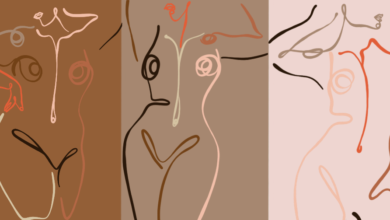Looking to build strength and endurance without heavy weights? Look no further than suspension training. This affordable alternative to larger pieces of exercise equipment still delivers an effective workout in the comfort of your own home. Developed by a United States Navy Seal, TRX founder and CEO Randy Hetrick designed this suspension trainer as a mobile gym that could give you an incredible workout to target every muscle.
“TRX suspension training helps to improve mobility, flexibility, strength, endurance, power, core strength and heart health,” says Stephanie Warwick. She says that this all-in-one piece of equipment can provide an effective workout whether you’re focusing on strength or conditioning. Plus, you can even use TRX to assist with balance and stability during stretching and mobility sessions.
When it comes to setting up your TRX system, Warwick says the easiest way is to anchor the TRX from a door that closes towards you to feel most secure. If you choose to fasten the system via an on your ceiling, Warwick shares that this will give you greater scope and more space to play with. But the TRX isn’t just for indoor home gym use. “The beauty of TRX is fitness anytime, anywhere,” Warwick says. “If you fancy taking your workout outdoors, find a beam, a tree or even the high bar at your local playground.” Just remember to pick a spot that is secure to avoid injury.
Fitness experts in the Good Housekeeping Institute Wellness Lab teamed up with Warwick and TRX to bring you the most effective TRX moves for all levels of fitness. Whether you’re looking for TRX exercises for beginners or a more advanced TRX workout plan, these moves have something for everyone. You can focus on one part of the body or create a full-body workout by sequencing these moves together. Before you start any fitness or training regimen, be sure to consult your physician or healthcare provider. If you’re new to TRX, Warwick offers some advice:
Tips for TRX Beginners
- Focus on fundamentals. “There are so many amazing exercises, don’t make the mistake of trying to jump in at the deep end,” Warwick says. Don’t be afraid to start slow and with more basic movements at first.
- Pay attention to form. Think about form and master that before adding more challenging variations to the moves. If your form is incorrect, you won’t get the most out of the workout. “Get your form right and you’ll progress much faster,” Warwick shares.
- Get familiar with the system. While you may be used to workout moves like a squat or bicep curl, the TRX system makes it more effective and it’s important to get familiar with the system so you understand how it works. “Take the time to understand the different strap lengths and how to adjust your TRX,” Warwick advises. “Then, you’ll be able to flow from push to pull to plank with ease.”
Low Row
“If you train mainly with bodyweight alone, chances are you’re missing an element of pull in your workouts,” says Warwick. This is one of the best TRX exercises for back, leaving you standing taller and feeling more confident too.
How to:
- Facing your anchor point, hold the rubber handles with your palms towards each other.
- Lean back, keep the weight in your heels with your tailbone tucked and core engaged.
- Walk forward to make your rows heavier and backward to make it lighter.
- Pull your chest through your hands and squeeze your shoulder blades together, keep your neck long and shoulders low.
- Lower with control to return to the starting position.
Bonus tip: Warwick says that if you find yourself sliding, plant your feet on the floor and put a soft bend in the knees and hips to maintain the straight line of your torso.
Chest Press
“Not only does the chest press make learning the correct form of a push-up more accessible, but it also eliminates flexion and potential discomfort in the wrist joint,” Warwick explains.
How to:
- Holding the rubber handles, face away from the anchor point with straps on your shoulders and arms straight.
- Walk back, and keep feet shoulder width apart. Lean into the straps and lift up on to your tip toes, keep a strong plank position with your tailbone tucked. Wrists are straight like a punch.
- Open your hands, bend at the elbow slowly, and lower your chest in line with your fists.
- Push away from the handles and straighten your arms.
Bonus tip: Keep your head still throughout the movement. Warwick also says that moving your feet closer to the anchor points makes it harder, while walking further from the anchor point makes it easier.
Y Fly
Warwick shares that this fundamental movement helps develop strength and mobility in the shoulders. This is one of our favorite TRX exercises for shoulders.
How to:
- Hold the rubber handles, and lean back in the straps with straight arms and palms facing down.
- Keep feet shoulder width apart and maintain a strict plank position. Pull your arms up and out so your body forms a Y shape.
- With your weight in the heels, walk towards the anchor point to make it heavier, and walk away to make it lighter.
- Focus on your shoulders (specifically the rear deltoid), lifting your whole body up and controlling your lowering phase. Your wrists and elbows should never bend.
Bonus tip: Warwick says to keep your hips still and limit momentum from the body to really focus on strengthening your shoulders.
Triceps Press
Build sculpted TRX arms with this tricep-focused move that helps to strengthen the upper body and create stability.
How to:
- Grab the handles, facing away from the anchor point.
- Start with arms straight and hands at forehead height, then your hands never move.
- Keep feet hip width apart, and lift up onto your tip toes and engage your core in plank position. Moving your feet towards the anchor point makes the exercise heavier, while walking forward makes it easier.
- Bend your elbows, lowering your whole body down into your plank position until your fists are level with your temples.
- Extend your arms and push away to return to the starting position.
Bonus tip: “Keep your elbows tracking in line with your shoulders,” Warwick advises. “If you let your elbows flair or hands lift, you’ll start to go into your shoulders.”
Biceps Curl
Create maximum strength with this bicep-focused movement that makes for an awesome TRX upper body exercise.
How to:
- Hold the rubber handles and lean back in the straps, palms facing up and feet shoulder width apart.
- Keep your shoulders set down your back.
- Curl your hands to the sides of your temples. Elbows stay at shoulder height to isolate your biceps.
- Pull back on the TRX as you extend your arms to lengthen under tension.
Bonus tip: Go slow and controlled with this movement and focus on isolating the muscle and not using momentum.
Plank
A TRX plank levels up the standard bodyweight plank, making it much more challenging. “It’s doubly important to be active and engaged in your plank because your feet are suspended,” Warwick says.
How to:
- Start with your feet in the foot cradles facing away from your TRX.
- Place your hands under your shoulders and push away from the floor, spreading your shoulder blades.
- Tuck your tailbone; you should feel active and engaged before your knees have left the floor. Start by extending one leg, then the other.
- With flexed feet, squeeze your quads, glutes and core. Keep your arms straight or regress to a forearm plank if you have discomfort in your wrists.
- Build your tolerance to resistance; when you feel your form slipping, drop to your knees: rest, reset and go again.
Bonus tip: “Keep a vertical hang on your TRX and avoid a negative hang which is where your TRX goes behind your anchor point and can drag you backwards,” Warwick adds.
Pike
Once you‘ve built stability in your plank, try adding movement. “The pike is a personal favorite of mine!” Warwick shares. She likes that this move helps to build core and shoulder strength while also testing your mobility.
How to:
- Start in a plank position, keeping your arms and legs straight. Lift your hips up and over your shoulders.
- Exhale to lift, inhale and return to neutral. Avoid dipping in the lower back.
- Work with your range of motion, shoulders stay stacked over your wrists.
Bonus tip: Look back at your toes as you lift to maintain a neutral spine.
Side Planks
“As soon as you suspended your feet in the TRX, you’ll be increasing the difficulty of your side plank, targeting not only your obliques but your stabilizing muscles too,” Warwick shares.
How to:
- Start in a forearm plank, and turn your right forearm to create an L shape.
- Place your left palm down, and bend your knees and point your toes to transition your feet in the loops.
- Slowly rotate your body, stacking your shoulders and hips.
- You can keep your left hand down to aid balance or lift and extend your arm to the sky for an extra challenge.
- Be active and lift your hips to engage through your obliques.
Bonus tip: If you start swinging, Warwick says to widen your legs for balance.
Shoulder Stand to V-Sit
This Pilates-inspired combination offers a stability challenge, making it one of Warwick’s favorite movements for TRX abs.
How to:
- Begin lying on your back with your head under the anchor point (or a couple of inches away from your door).
- Press your hands down into the foot cradles, and keep your arms straight and extend your legs in line with your hips.
- Lift your hips off the floor, rolling up into your shoulder stand.
- As you roll down, keep your arms straight and sit up into a V-sit. Bend your legs if you have tight hips and hamstrings.
- Roll back and lift to your shoulder stand, extend your legs to the sky, toes in line with your eyes. Avoid rolling over and letting your feet go over your head.
Bonus tip: You may be tempted to grip the handles here, but Warwick says if you bend your arms, it’s game over. Try pressing your hands down and keeping your arms straight to help stabilize your shoulders.
Side Bend
This is another one of Warwick’s personal favorite core exercises, especially if you are training outside and don’t want to go down to the ground.
How to:
- Stand facing the side on to your anchor point, holding one handle with your outside arm.
- Place the handle on your head and rest your inside hand on top. Elbows are wide and the handle stays on your head, feet together, tailbone tucked and core engaged.
- Inhale, lowering your hip away from your TRX. Feel your obliques engage.
- Exhale and return to the start position.
Bonus tip: Warwick says to focus on squeezing your elbows wide to keep your back engaged. “Before you move, look along your inside arm and check to make sure you’re in line with your TRX anchor point,” she adds.
Squats
A quintessential lower body move gets an upgrade by incorporating suspension training, making it one of the best TRX exercises for legs.
How to:
- Grab the handles with tension on the strap, and elbows in line with your ribcage.
- Step feet shoulder width apart and sit hip crease below the knees without leaning back.
- Hinge your body forward and keep your elbows bent. This keeps the work in your legs.
- Stand and squeeze your glutes and quads at the top of the movement.
Bonus tip: Hinge your body forwards, so the line of your spine matches the line of your shins. Don’t hang back in the straps! Keep your elbows bent and the weight in your legs.
Step Back Lunges
“Since the TRX provides extra stability, you’ll be able to focus on your posture and knee alignment here,” Warwick explains. She says to make sure your knee tracks your middle toe and to avoid collapsing in or dropping out.
How to:
- Grab the handles with tension on the strap, and elbows in line with your ribcage.
- Lift your right knee.
- Step back into a lunge, both knees at 90 degrees, with your back knee just kissing the floor.
- Stand up and bring your right knee through as you squeeze your left glute. Go down and up, not backwards and forwards.
Bonus tip: Your arms shoulder never straighten.
Crossing Lunge
“This lunge variation targets the glutes, working ankle, and knee and hip mobility,” Warwick notes. You can try adding a swing kick to the side instead of the knee lift for a dynamic hamstring stretch.
How to:
- Grab the handles with tension on the strap, and elbows in line with your ribcage.
- Lift your right knee to the diagonal, and squeeze your glutes to open your hip.
- Bend the knees and collapse the right shin to the floor, feeling a stretch in your left glute.
- Stand up, taking your knee back to the start position and straightening your standing leg.
Bonus tip: Warwick says it’s important to think about collapsing your ankle so your shoelaces come to the floor (rather than tucking your toe, as you would in a step back lunge). This gives you greater depth and more glute work.
Hip Press
Support your glutes and hips with this simple yet effective workout movement for TRX lower body exercises.
How to:
- Lie on your back directly under your anchor point (a couple of inches away from your door if using a door anchor).
- Use your index fingers to place both heels simultaneously into the foot cradles.
- Bend knees at 90 degrees and keep them bent.
- Press down in your heels, lift your hips and create a ski slope position; focus on a diagonal line from knees, through hips, to shoulders.
- Roll down through the spine to return to the start position
Bonus tip: Warwick says to squeeze your glutes at the top to get full hip extension and full range of movement.
Hamstrings Runner
In this efficient lower body move, make sure that both legs stay active.
How to:
- Lie on your back directly under your anchor point (a couple of inches away from your door if using a door anchor).
- Use your index fingers to place both heels simultaneously into the foot cradles.
- Press down in your heels, legs straight and lift your hips off the floor. Keep equal pressure with both heels pushing down.
- Alternate bending and straightening the legs.
Bonus tip: “If you only push down through one heel, the TRX will sway from side to side and you’ll lose stability,” Warwick says.
Stefani Sassos, MS, RDN, CSO, CDN
Registered Dietitian
Stefani Sassos is a Registered Dietitian Nutritionist with a Bachelor of Science degree in Nutritional Sciences from The Pennsylvania State University and a Master of Science degree in Clinical Nutrition from New York University.
This content is created and maintained by a third party, and imported onto this page to help users provide their email addresses. You may be able to find more information about this and similar content at piano.io








